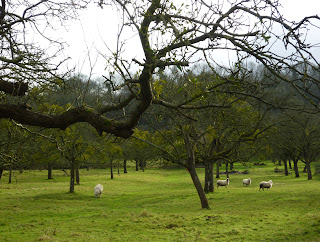It doesn't look too bad from a distance. Creamy white, reasonably lustrous… feels relatively soft, not harsh. Could be good, but look at it more closely.
There are inconsistencies, curds of shorter, finer fibre. Also, as you can see, sliver is a carded prep, not combed; the fibres are not parallel, they're interlocked. But this is Cotswold… a long wool. What's going on?
Above are Cotswold locks, unwashed and washed. Below, fibres pulled from the sliver to check staple length (and therefore more parallel, similar to top, than they were in the sliver itself).
Check the staple length: it is long. (With those embedded tufts of finer, shorter wool just waiting to add … character … to the spun yarn.) I did sample it; I can't find the sample to show you, but spun with a point-of-contact long draw I assure you it seemed to me a relatively nasty yarn, hard to draft (the long fibres run through both slubs and twist-locked thinner areas, so the slubs cannot be drafted unless the twist-locked areas are freed). Definitely characterful and not in a good way. The wrong fibre (Cotswold) in the wrong place (a carding machine) at the wrong time (when it was carding).
The fibres are unsorted, so ignore directionality such as butt and tip. Just lash the sliver on, then comb. In general more passes will give better results, assuming you don't stress, weaken and snap the fibres. In any fibre prep, watch what you're doing and if you notice more nepps than when you began, Stop! (And next time, stop before the nepps form.) I don't think this was wonderful fibre to start with; some of the sliver contains a lot of darker hairs and other areas contain dull, short fibres, so I give it only two passes. I have fleeces more deserving of that processing time.
The photo clearly shows that combing has done a good job of separating the long fibres from the short. Diz off the long fibres and:
there is a nest of roughly-combed top. There are still some nepps in it, but I can live with that. Above the top is the combing waste, composed of second cuts plus shorter, finer fibres from the base of the fleece, plus nepps formed from longer fibres broken in the carding process. In the medieval period combing waste was spun woollen to become weft for relatively low-grade cloth that was finished by fulling and perhaps brushing to raise a nap on the surface. I plan to try that with this waste, but if it's too nasty, I'll use some other softer, fullable wool. The top will be the warp yarn for this cloth. It's not too bad. That sheep was not shorn in vain.
Next, another fibre - or rather, fibres - in the wrong place at the wrong time.
Weaving! Janet Phillips showed me a different way to hold the lease sticks for threading, and I thought I'd share it - and my refinement of it - with you. For my first warps I had the lease sticks on lengths of string running from castle to back beam. I found this awkward, so was pleased to hear about Angel Wings, which attach to the Baby Wolf back beam to hold the lease sticks securely in a fixed position. But I found them awkward, too. The cross was a long way behind the heddles. Janet uses string but ties hers much nearer the castle, bringing the cross much nearer the heddles. I couldn't find a good, quick way to try her tying method on the Baby Wolf, then realised I didn't need to: two hooks off the kitchen pot rack would do the job. A loop of thick cord is passed between each end of the lease sticks, then hung from the hook. And, even better, the tube work light I bought for my husband sits across the hooks to shed light on the cross while I'm working. It works really, really well.
(The light is not so ferociously bright as it appears in the photo.) You may notice some strangely yellow heddles in that shot; they're string heddles, tied to correct a stupid mistake: I miscounted the heddles when setting up to thread. I work from right to left, and the Baby Wolf shafts have a fitting in the middle that prevents heddles sliding across from the left side to the right. I could had pulled all 200-odd threads out, added more heddles, then re-threaded, but why would I want to do that? Far faster to cut some lengths of smooth, shiny mercerised cotton, loop it around the bottom of the shaft, tie two knots to define the heddle eye, then knot the ends loosely around the top of the shaft. Magic! The right fibre (cotton) in the right place (my thrums bag) at the right time (when I need it).
The wrong fibres (remnants of handspun lace yarn in tussah silk, cashmere, camel down) in the wrong place (on a loom) at the wrong time (as an unsized warp). I fear this will end badly, as the soft, blooming ends were catching on each other and causing uneven tension in the warp while I was winding it. I should have sized the warp after winding or, even better, skeined the balls of leftover yarn and sized it before winding the warp. But I was concerned only about the behaviour of the warp while weaving, so planned to size it on the loom. I'll know better next time. I'll persevere with this because dealing with the uneven tension will be educational (ha!) and, well. It's just so pretty…




































